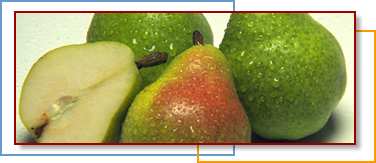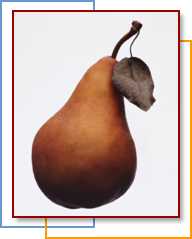
Pears (Pyrus communis) are a pome fruit relative of the apple. One of
the earliest written histories or records comes from Homer's reference to
them as "Gifts from the Gods." The first pears arrived in the
United States by European settlers in the 1700s. Pears rank second to the
apple as the most popular US fruit. They can be eaten and used in a lot of
the same ways as the apple. One distinct feature of the pear besides the
shape is the soft texture. This soft texture is the result of the starch
converting to sugar after being picked from a tree to ripen. (Wellness
Encyclopedia of Food and Nutrition, 1992).
|
|
Pear
|
Serving size
1/2 cup, sliced (83g)
|
Amounts
Per Serving |
% Daily
Value |
| Calories
50 |
|
| Calories
from Fat 0 |
0 |
| Total Fat 0g |
0% |
| Saturated
Fat 0g |
0% |
| Sodium 0mg |
0% |
| Cholesterol
0mg |
0% |
| Total
Carbohydrate 13g |
4% |
|
Dietary Fiber 3g |
12% |
|
Sugars 8g |
|
| Protein 0g |
|
| Vitamin A |
0% |
| Vitamin C |
6% |
| Calcium |
0% |
| Iron |
0% |
* Percent Daily Values are based on a
2,000 calorie diet. |
|
| |
|
The very shape of a pear speaks of its luscious nature. When ripe and
ready to eat, the pear has a honeyed flavor and beckoning perfume that
bewitch your senses. There are more than 3000 known varieties in the
world. US production comes from states in the Northwest, plus New York,
Pennsylvania, Michigan, and California. Imports come from South America,
Canada, New Zealand, and South Africa.
With the numerous varieties and extended growing seasons, pears of all
sizes and colors are available year-round.
There are several varieties of pair including Anjou, Bartlett, Bose,
Comice, Forelle, and Seckel. These fruits have a sweet, rich flavor and
come in a variety of colors including green, golden yellow and red. Among
these varieties there are only subtle differences in flavor and texture.
Pear Varieties
Pears come in a variety of shapes, sizes, and colors from tiny Seckels
to long-necked Boscs to colorful Red Bartletts. Check out their
availability and use below.
 Green
Anjou — Available October through June Green
Anjou — Available October through June
Firm and green, even when ripe; this large, thin-skinned yellowish-green
pear is best eaten fresh. When slightly under-ripe, it can be baked or
poached, but once it ripens, its sweet, mellow flavor and abundant juice
make it an excellent choice for salads and snacks.
 Red
Anjou — Available October through May Red
Anjou — Available October through May
Much the same flavor, use and texture as the green Anjou. Red Anjous
(generally dark, maroon red in color) show little to no change in color as
they ripen, which is another characteristic shared with their Green Anjou
counterparts. Red Anjous are recognizable for their near egg-shaped
appearance.
 Yellow
Bartlett — Available August through December Yellow
Bartlett — Available August through December
One of the most common and popular pears, this large, bell-shaped
all-purpose pear has a yellow skin sometimes blushed with pale red. It is
very sweet, juicy, aromatic and perfect for salads, eating fresh, and
excellent for canning or cooking. It holds its shape and flavor in baking
and cooking.
 Red
Bartlett — Available August through December Red
Bartlett — Available August through December
Firm, bright red skin, very sweet and juicy when ripe. This variety is a
bit smaller, with the same flavor, texture, and use as yellow Bartletts.
They make an excellent choice as a color accent in a fresh-fruit dessert
or salad.
 Bosc
— Available August through April Bosc
— Available August through April
The Bosc has a firm, dense, yet tender flesh with brown skin that hides a
deliciously, sweet and spicy flavor. Its dense flesh makes it ideal for
baking and cooking. Color doesn't change as it ripens, excellent for
baking. Its mild, not-too-sweet flavor is great for microwave recipes,
salads, and snacks.
 Comice
— Available August through March Comice
— Available August through March
Is hard, green, and rounder than a Bartlett, but similar in flavor and
texture. One of the largest, sweetest and juiciest varieties. Best used
fresh in salads, served as an elegant dessert pear, or as an excellent
accompaniment with cheese.
 Forelle
— Available September through February Forelle
— Available September through February
Slightly larger than a Seckel, with freckled skin and a red blush. For
what they lack in size, Forelle pears make up in sweet flavor and
beautiful appearance. They're an excellent snack or lunch-box pear…sweet,
juicy, and crisp.
 Seckel
— Available August through February Seckel
— Available August through February
Tiny pears with ultra-sweet flavor, so sweet in fact they are called
"sugar pears." Maroon and olive green in color, with no color
change when ripened. They are an excellent choice for children's snacks,
pickling, or as a garnish.
They have no cholesterol, sodium, or saturated fat. They offer a
natural, quick source of energy, due largely to high amounts of two
monosaccharides: fructose and glucose, plus Levulose, the sweetest of known
natural sugars, found to a greater extent in fresh pears than in any other
fruit. A pear is a nutrient dense food, providing more nutrients per
calorie, than calories per nutrient. Carbohydrates make up 98% of the
energy provided by a pear, and carbohydrates are helpful in weight
reduction diets because they contain half as many calories as fat.
Fiber
Fresh pears offer dietary fiber, much of it in the form of Pectin. A
pear weighing 166 grams provides 2.32 grams of crude fiber, and 4 grams of
dietary fiber, of which 41% is pectin. Fiber contains no calories, and is
a necessary element of a healthy diet, helping to sustain blood sugar
levels and promoting regularity. High fiber diets may also help reduce the
risk of colon cancer and can help reduce serum cholesterol. Pears are a
good source of natural fiber.
Potassium
Fresh pears offer potassium; 210 mg in a medium size pear. Although it
is an element lost easily through dehydration or perspiration brought on
by active lifestyles or strenuous exercise, potassium is necessary for
maintaining heartbeat, muscle contraction, nerve transmission, as well as
carbohydrate and protein metabolism. Replenish potassium by eating fresh
vegetables, fruits or legumes containing high potassium content— pears
are an excellent choice.
Vitamin C
Fresh pears contain Vitamin C. One medium size pear provides 7 mg, or
10% of the RDA for Vitamin C. As one of the antioxidant vitamins, Vitamin
C is essential for normal metabolism and tissue repair, helping prevent
free radical damage the destructive by-products of the body's metabolic
process. Vitamin C improves the immune system and promotes healing of cuts
and bruises and guard against a number of infectious diseases. Fresh pears
are a good source for Vitamin C.
Sweet, succulent pears are perhaps the most glorious of fall fruits.
Selecting them can be easy if you consider the following: avoid pears with
bruises or cuts and dark brown colors; purchase pears while slightly green
because they ripen better and faster off the tree; look for pears with a
smooth unblemished skin; ripe ones will yield slightly to gentle pressure
at the stem end. If you plan to bake pears, select those that are fairly
firm.
If pears are unripe, place them in a paper bag at room temperature for
2 to 3 days or store them in a ventilated fruit bowl in a cool, dark
place, and refrigerate as soon as they ripen. Ripe pears should be stored
in the refrigerator in a plastic bag up to 3 days. They continue to ripen
after harvest.
There's no need to peel a pear... their tender, edible skin is an
additional source of fiber. A medium sized pear provides 4 grams of fiber,
or 16% of the recommended daily value. Always wash all fresh fruits and
vegetables before serving.
Recipes
 Baked
Pears with Lemon Sauce Baked
Pears with Lemon Sauce
Makes 4 servings.
By PBH/Carol Withers
Ingredients
4 pears (medium-sized), peeled
3 Tbsp. Water
1 Tbsp. Honey
2 whole cloves
2 tsp. cornstarch (for Lemon Sauce)
3/4 cup skim milk, divided (for Lemon Sauce)
1 cinnamon stick (for Lemon Sauce)
1/2 tsp. grated lemon rind (for Lemon Sauce)
3 Tbsp. lemon juice (for Lemon Sauce)
1 Tbsp. honey (for Lemon Sauce)
Cut pears in half lengthwise and remove cores. Arrange pears, cut side
up, in a glass baking dish. Combine water, honey and cloves and pour over
pears. Cover and bake at 350° for 25 to 30 minutes. Serve warm pears with
1/4-cup chilled lemon sauce.
To make sauce combine cornstarch and 1/4-cup milk in a small saucepan,
stirring until blended. Add remaining 1/2-cup milk and cinnamon. Simmer
over medium heat 6 to 8 minutes, stirring constantly, until mixture is
thickened. Reduce heat and stir in remaining ingredients until well
blended. Remove from heat and cool to room temperature. Cover and
refrigerate 3 hours or until thoroughly chilled. Remove cinnamon stick
before serving.
Nutritional analysis per serving: Calories154, Fat 1g, Calories from
Fat 5%, Cholesterol
1 mg, Fiber 6 g, Sodium: 27 mg.
Find more in our
recipe database!
|



